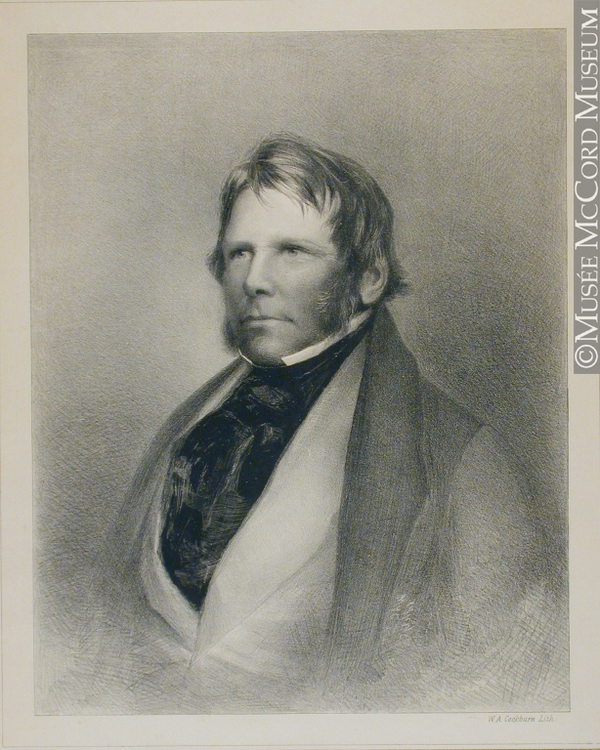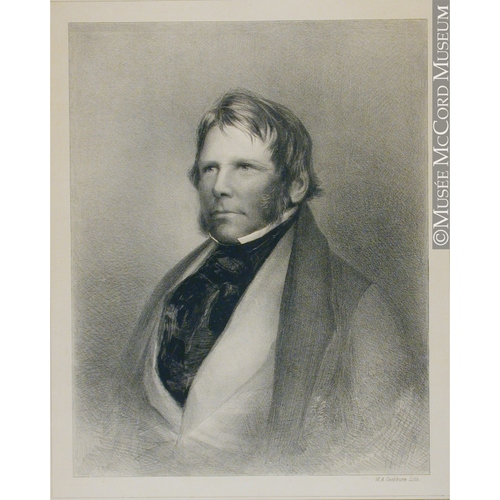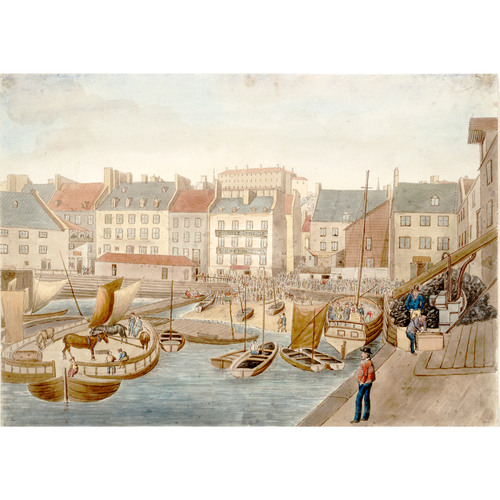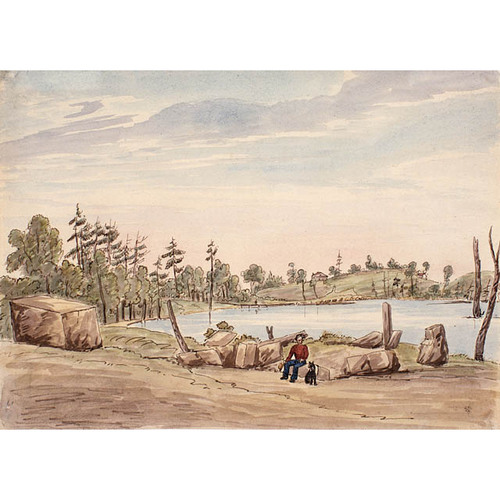
Source: Link
COCKBURN, JAMES PATTISON, army officer and water-colourist; b. 18 March 1779 in New York City, son of Colonel John Cockburn and Mary Cockburn, daughter of Colonel Sir James Cockburn; m. 1800 Elizabeth Johanna Vansittart in Cape Colony (South Africa), and they had five sons and two daughters; d. 18 March 1847 in Woolwich (London).
James Pattison Cockburn was raised in a family of soldiers. On 19 March 1793 he entered the Royal Military Academy at Woolwich as a cadet, and there he was taught drawing, in the main under the chief drawing-master, Paul Sandby. To this two-year period of training belongs The Royal Laboratory, Woolwich, a water-colour in which Cockburn showed himself a skilled topographer with a strong sense of perspective and a fine, precise hand in drawing. Several figures in motion give life to the composition and prevent it from being only a topographical landscape. These characteristics would be the hallmark of his style.
Cockburn participated in the taking of Cape Colony in September 1795 and in an expedition against Manila in 1798. In 1803 he was back in England, and on 1 June 1806 he obtained the rank of captain in the artillery. His company was at first stationed at Colchester, and then in August and September 1807 was sent to Denmark, where Cockburn joined in the siege of Copenhagen. In November a set of five coloured aquatints made from his drawings recording the military operation was published. These early engravings fit into a strict topographical tradition, inherited from the 17th century, in which landscape is subordinated to the representation of sites and events. Cockburn was listed as sick from 10 Sept. 1807 until late November 1808, when he was located in Norwich. His years in the garrison there, until November 1814, were quiet except for the siege of Antwerp (Belgium) in August 1809, during which he led a flotilla with distinction and thus was awarded the task of negotiating the terms of surrender. From the expedition there remains a coloured aquatint map engraved from his drawings, the work of a cartographer in the style of Dutch artists Pieter Jansz Saenredam and Gaspar Van Wittel, which well illustrates the instruction given at the Royal Military Academy.
From 31 July to 12 Aug. 1809 Cockburn, as an honorary member, exhibited 17 water-colours at the Norwich Society of Artists, including some of Cape Colony and Bengal. He was experiencing a period of vital importance in his development as an artist. Through his contacts with the landscape painters of the Norwich school, in which Dutch and Italian influences blended, and particularly with the studios of John Sell Cotman and John Thirtle (reputedly his teacher), Cockburn’s technique acquired a spontaneity it had lacked. The draftsmanship is less precise, and the result is to heighten the effect of the very diffused colouring, with the sombre tones in the foreground (deep ochres to pale olive-green) shading to light in the background. The eye is drawn to the atmospheric effects, such as the great diagonals of the sun’s rays.
Cockburn returned to Colchester in December 1814 with the rank of brevet-major accorded him on 4 June. He stayed there till early in 1817. A sketch-book of August 1815 gives proof of a period at Woolwich and walks along the Thames. His symmetrical use of space demonstrates his mastery of composition. These drawings also reveal his way of working in front of the subject, which did not change much subsequently. He employed graphite, on its own or retouched with pen and with a brown ink wash, or else he used a sepia wash by itself that showed the shapes and the shades of light.
The Napoleonic Wars over, Cockburn went to stay on the Continent more frequently, working for William Bernard Cooke, an English engraver and publisher. In March 1816 and again in 1817 and 1818 he was at Naples and Pompeii, doing topographical sketches of the excavations. According to German composer Louis Spohr, to whom he showed more than 200 landscapes of Naples and its surroundings, Cockburn had “extraordinary skill in catching charming views in a matter of minutes.” He was becoming an indefatigable sketcher. In the period 1816–22 he produced drawings in sepia as he moved from place to place in the Alps and elsewhere in Italy and Switzerland: vast panoramas and mountain passes figured alongside scenes of streets and market places. The wealth of pictures is explained not only by Cockburn’s mastery of technical means but also, according to Spohr, by his use of “a machine that projected the landscape, in reduced scale, on paper.” Although it is not certain that Spohr was referring to a camera lucida, the sharpness of the images in several sketches done at the time he made his remark in some measure substantiates this hypothesis.
Cockburn arrived in Lower Canada in November 1822. His visit was brief, since he left again on 17 June 1823, and his company followed in August. As a result there are few sketches from this first trip. A water-colour entitled Cape Diamond from below no 1 tower, dated 29 Oct. 1823, suggests Cockburn did studies that he reworked in his studio according to his usual practice. Back in Woolwich, he received the rank of major in his regiment on 29 July 1825 and was promoted lieutenant-colonel the same day. On 5 April 1826, at 47 years of age, he was given command of the Royal Artillery in the Canadas, to which he returned in August.
During these years of peace Cockburn had ample leisure to sketch Quebec and its environs as well as scenes in Upper and Lower Canada where his tours of inspection took him. Thus his subjects extend from Quebec to Niagara Falls. The idiom is firmly established in the drawings in sepia or water-colour from this mature period. The order and clarity of arrangement rest upon two constants: following a classical approach, the landscape is drawn in parallel planes; and a diagonal line (street, sidewalk, path, or river) is used to organize the elements in the composition, directing the eye from the foreground straight to the background. In his drawings of Quebec streets Cockburn reveals his debt to Paul Sandby: a soft light plays over a limited range of colours forming rhythmical compositions in pale tonalities and attenuating the analytical spirit of these water-colours. The artist’s interest in community life is also evident in depictions of solemn occasions (religious processions), daily activities (men cutting ice), and anecdotal scenes (market days). These drawings, however, reveal only one aspect of his personality. Cockburn looked at nature in the Canadian countryside as a true landscape artist: he was able instinctively to find the best angle of approach and arrangement of physical features. With this ability he drew picturesque and poetic compositions, which were seldom dramatic or sublime, except perhaps for certain views of Niagara Falls. Observation of small details is still present: stratified rocks, sodden roads through heavy clay, effects of light on snow and ice. In 1831 he brought out anonymously a small “picturesque guide” to the town of Quebec and its environs illustrated with seven plates. But he turned out nothing comparable to his previous publications. On 2 Aug. 1832 he left Quebec with his family.
Cockburn settled in Woolwich, where he owned a house, and on 10 Oct. 1838 became director of the Royal Laboratory of the Royal Arsenal there. He retained this post until 15 Nov. 1846, when he retired with the rank of major-general, which had been accorded him on 9 November. His health deteriorated rapidly, and he died at his residence in Woolwich on 18 March 1847.
Cockburn produced an enormous body of work. Paradoxically, it has been studied only superficially and consequently in large measure remains to be reconstructed. The reason is simple: it is sometimes difficult to distinguish between the sketch done from life and the work done in the studio. The sketch done from life seldom has any room for improvisation and already reveals the artist’s poetic idiom; the work done in the studio retains the freshness of first impressions yet has been developed in the artist’s mind.
After his death James Pattison Cockburn was not completely forgotten. In August 1860 nine of his water-colours were exhibited by the Norfolk and Norwich Fine Arts Association in a show to honour “local artists who were deceased.” In a review in the Norwich Mercury his name appeared along with the famous names of the Norwich school, and he was called an “excellent artist.” Time has but confirmed the esteem in which Cockburn was held during the period he spent at Quebec. Joseph Légaré*, upon whom he had a lasting effect, certainly shared this opinion. Légaré’s direct copies and his occasional borrowings, his imitations of technique and his pasticcios, are indicative of an influence, rather than of intellectual affinity. Cockburn was thus one of the few British artists, if not the only one, in the early 19th century to impart his view of nature to a Quebec landscape artist.
[James Pattison Cockburn is the author of Swiss scenery from drawings (London, [1820]), illustrated by 60 prints from his drawings; the book was described as “nearly ready for publication” in the November 1818 issue of Gentleman’s Magazine (p.445). An anonymous work, Quebec and its environs ; being a picturesque guide to the stranger, published in Quebec in 1831, was attributed to him first by Lady Aylmer, in her “Recollections of Canada, 1831” (ANQ Rapport, 1934–35: 283), and then in A dictionary of books relating to America, from its discovery to the present time, comp. Joseph Sabin (29v., New York, 1868–1936; repr. 29v. in 15, Amsterdam, 1961–62), 3: 200. It was certainly in the publisher’s hands by 1829: in writing The picture of Quebec (Quebec, 1829), George Bourne drew extensively on it, virtually to the point of plagiarism, for the chapter “Itinerary” (pp.64–71).
A number of prints based on Cockburn’s drawings were brought out in London either separately or in collections. These were, in chronological order, The siege of Copenhagen (1807), consisting of five aquatints; Pictural plan of the grand expedition in the West Schelt, Augt 1809 ; shewing the difficulty of approach to Antwerp (1809), one aquatint; View of the Royal Artillery barracks and View of the Royal Military Academy (1816), two aquatints (derived probably from drawings in his August 1815 sketch-book, from which only the two middle leaves have been removed); Views to illustrate the route of Mont Cenis, drawn from nature (1822), 50 plates; Views to illustrate the route of the Simplon, drawn from nature (1822), 50 plates (because the copy at the BL contains a text in 81 manuscript folios which describes the voyage and is entitled “Simplon,” it is conceivable that Cockburn’s intention was to produce a publication similar to Swiss scenery) ; Views in the valley of Aosta, drawn from nature (1823), 29 plates; and Quebec and The falls of Niagara (1833), two sets of six aquatints (the series The falls of Niagara was republished in 1857). Montmorency waterfall & cone, near Quebec and Horse-Shoe Fall, Niagara, coloured prints published in 1844 and based on drawings of William Purser and Thomas Allom, were new studies in Cockburn’s style.
In addition, Cockburn contributed his drawings to various publications, the first, on which he collaborated with the English engraver William Bernard Cooke, appearing as Delineations of the celebrated city of Pompeii (London, 1818). Projected to comprise two volumes in four parts and to be illustrated by 50 picturesque views, the work was described in the January 1818 issue of Gentleman’s Magazine (p.61) as being “nearly ready for publication.” A comparison of copies held at the BL and at the Bibliothèque nationale in Paris (Estampes, Vf.219) suggests that there were two editions, the first probably published in 1818 or 1819, and the second in 1827 with the plates in a different order, additional prints, and a new title. Two of Cockburn’s drawings were engraved for George Newenham Wright’s The Rhine, Italy, and Greece, in a series of drawings from nature . . . with historical and legendary descriptions (2v., London and Paris, [1841]).
The principal collections of Cockburn’s Canadian works are those of the Royal Ont. Museum in Toronto; the National Gallery of Canada and the Picture Division of the PAC, both in Ottawa; the McCord Museum in Montreal; and, in Quebec, the Musée du Québec, the Musée du Séminaire de Québec, and the ANQ-Q. Although his European works remain for the most part in private hands, public collections are in the British Museum (London), Dept. of Prints and Drawings; the Norwich Castle Museum (Norwich, Eng.); and the Royal Military Academy (Sandhurst, Eng.). d.p.]
GRO (London), Registration of death index, no.376, 27 March 1847 (copy at Somerset Record Office (Taunton, Eng.)). MAC-CD, Fonds Morisset, 1, Montréal, île de Montréal, bibliothèque municipale et album Viger; Québec, séminaire de Québec, archives, cartes et peintures. PAC, RG 8, I (C ser.), 747: 122, 125–26a; 748: 1–109; RG 37, A2, 298, 339. PRO, PROB 11/2055: 332 [392]; WO 17/1526: 158; 17/1527: 80; 17/1530: 105; 17/1536: 119; 17/2561; 17/2582; WO 55/1225–27, esp. 55/1227: 179–80; WO 76/360: 60.
Catalogue of the fifth exhibition by the Norwich Society of Artists in oil & water colours . . . (Norwich, 1809). Gentleman’s Magazine, 1809: 763, 863–64; January–June 1847: 550–51. Records of the Royal Military Academy, 1741–1892, ed. H. D. Buchanan-Dunlop (2nd ed., Woolwich [London, 1895]). Norfolk Chronicle and Norwich Gazette (Norwich), 29 July 1809, 1 Sept. 1860. Norwich Mercury, 29 July, 5, 12 Aug. 1809. Quebec Gazette, 19 June 1823, 23 Nov. 1829, 1 Aug. 1832, 13 Dec. 1833. Quebec Mercury, 8 April 1828.
Jeremy Adamson, From ocean to ocean: nineteenth century water colour painting in Canada (Toronto, 1976), 5. Allgemeines Lexikon der bildenden Künstler von der Antike bis zur Gegenwart . . . , ed. Hans Vollmer (37v., Leipzig, [German Democratic Republic], 1907–50), 7: 146–47. Mary Allodi, Canadian watercolours and drawings in the Royal Ontario Museum (2v., Toronto, 1974), 1, nos.270–463. Battery records of the Royal Artillery, 1716–1859, comp. M. E. S. Laws (Woolwich, 1952), 127–86. W. M. E. Cooke, The last “Lion”: . . . rambles in Quebec with James Pattison Cockburn (Kingston, Ont., 1978); W. H. Coverdale Collection of Canadiana: paintings, water-colours and drawings (Manoir Richelieu collection) (Ottawa, 1983), 43–60. Dictionnaire critique et documentaire des peintres, sculpteurs, dessinateurs et graveurs de tous les temps et de tous les pays (nouv. éd., 10v., Paris, 1976), 3: 87. DNB. Harper, Early painters and engravers, 69; Everyman’s Canada; paintings and drawings from the McCord Museum of McGill University (Ottawa, 1962), 68–70. Historical records of the Seventy-Ninth Regiment of Foot or Cameron Highlanders, comp. Robert Jameson (Edinburgh and London, 1863). List of officers of the Royal Regiment of Artillery, as they stood in the year 1763, with a continuation to the present time . . . , comp. John Kane (Greenwich [London], 1815), 26. List of officers of the Royal Regiment of Artillery from the year 1716 to the present date, comp. John Kane (rev. ed., Woolwich, 1869), 25, 103. H. L. Mallalieu, The dictionary of British water-colour artists up to 1920 (Woodbridge, Eng., 1976; repr. 1984), 63. The New-York Historical Society’s dictionary of artists in America. 1564–1860, comp. G. C. Groce and D. H. Wallace (New Haven, Conn., and London, 1957; repr. 1964). Norfolk and Norwich Fine Arts Assoc., Exhibition of the works of deceased local artists, at the government school of art, in the Norwich Free Library (Norwich, 1860), 13–15. Quebec almanac, 1823: 198; 1827: 205, 210; 1828: 145, 150; 1829: 159, 164; 1830: 161, 166; 1831: 183, 187; 1832: 173, 177. Miklós Rajnai, The Norwich Society of Artists, 1805–1833: a dictionary of contributors and their work (Norwich, 1976), 27, 104, 130, 137. Samuel Redgrave, A dictionary of artists of the English School: painters, sculptors, architects, engravers, and ornamentists; with notices of their lives and works (2nd ed., London, 1878; repr. Bath, Eng., 1970), 89. Ann Thomas, Fact and fiction: Canadian painting and photography, 1860–1900 (Montreal, 1979), 16–22. W. T. Vincent, The records of the Woolwich district (2v., Woolwich, 1888–90), 1: 368; 2: 462, 745.
Marjorie Allthorpe-Guyton, John Thirtle, 1777–1839 ; drawings in Norwich Castle Museum ([Norwich], 1977). Michael Bell, From Annapolis Royal to the Klondike; painters in a new land (Toronto, 1973), 11–12, 47, 49, 73–74, 221. J. A. Browne, England’s artillerymen; an historical narrative of the services of the Royal Artillery (London, 1865). Christina Cameron et Jean Trudel, Québec au temps de James Patterson Cockburn (Québec, 1976). Robert and H. A. Cockburn, The records of the Cockburn family (Edinburgh, 1913) [containing a portrait of J. P. Cockburn, a copy of which is in the McCord Museum]. C. P. de Volpi, The Niagara peninsula, a pictorial record . . . (Montreal, 1966); Quebec, a pictorial record . . . , 16081875 (n.p., 1971). Pierre Doyon, “Les aquarellistes britanniques de l’Académie royale militaire de Woolwich et la représentation du paysage québécois, de 1759 à 1871” (2v., thèse de ma, univ. de Montréal, 1982), 1: 102–30. Harper, Painting in Canada (1977). A. W. Moore, The Norwich school of artists ([Norwich], 1985), 79. Morisset, Coup d’œil sur les arts, 80–81; La peinture traditionnelle, 75–77, 84. Fulgido Pomella, Piemonte, Valle d’Aosta, Nizza e Savoia, Valli Valdesi nelle illustrazioni di William Brockedon e William H. Bartlett (Ivrea, Italy, 1982), 14–15. D. R. Reid, A concise history of Canadian painting (Toronto, 1973), 29–30, 36. F. St G. Spendlove, The face of early Canada: pictures of Canada which have helped to make history (Toronto, 1958), 46–51. Louis [Ludwig] Spohr, Autobiography (2v., London, 1865; repr. 2v. in 1, New York, 1969). B. M. Stafford, Voyage into substance: art, science, nature and the illustrated travel account, 1760–1840 (Cambridge, Mass., and London, 1984), 83, 91, 242, 272, 420. N. P. Willis, Canadian scenery illustrated, from drawings by W. H. Bartlett (2v., London, 1842; repr. Toronto, 1967). T. S. R. Boase, “English artists and the Val d’Aosta,” Warburg and Courtauld Institutes, Journal (London), 19 (1956): 288–89. W. E. Greening, “Some early recorders of the nineteenth century Canadian scene,” Canadian Geographical Journal (Ottawa), 66 (January–June 1963), no.4: 126–27. Ignotus [Thomas Chapais], “Le monument Wolfe et Montcalm à Québec,” BRH, 5 (1899): 305–9. Norwich Mercury, 22, 29 Aug. 1860. Notes and Queries (London), 14 Oct., 11 Nov. 1865; 9 July 1910; 31 Aug. 1912. F. St G. Spendlove, “The Canadian watercolours of James Pattison Cockburn (1779?–1847),” Connoisseur (London), 133 (1954), no.537: 203–7. Jean Trudel et Christina Cameron, “Québec vu par Cockburn,” Vie des Arts (Montréal), 19 (automne 1974): 55–57.
Cite This Article
Didier Prioul, “COCKBURN, JAMES PATTISON,” in Dictionary of Canadian Biography, vol. 7, University of Toronto/Université Laval, 2003–, accessed December 30, 2025, https://www.biographi.ca/en/bio/cockburn_james_pattison_7E.html.
The citation above shows the format for footnotes and endnotes according to the Chicago manual of style (16th edition). Information to be used in other citation formats:
| Permalink: | https://www.biographi.ca/en/bio/cockburn_james_pattison_7E.html |
| Author of Article: | Didier Prioul |
| Title of Article: | COCKBURN, JAMES PATTISON |
| Publication Name: | Dictionary of Canadian Biography, vol. 7 |
| Publisher: | University of Toronto/Université Laval |
| Year of publication: | 1988 |
| Year of revision: | 1988 |
| Access Date: | December 30, 2025 |







